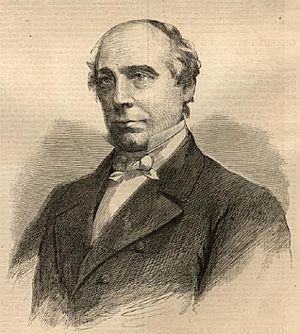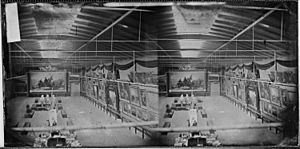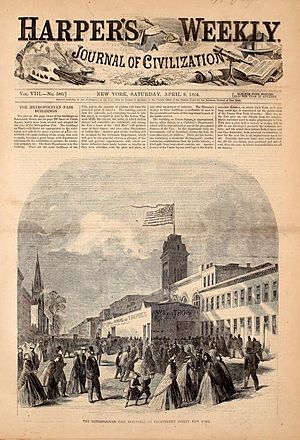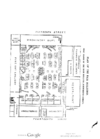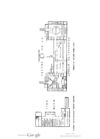Metropolitan Fair facts for kids
| Date | April 4–23, 1864 |
|---|---|
| Venue | Twenty Second Regiment Armory |
| Location | 643 Park Ave, New York, NY, USA |
| Type | Fair |
| Cause | Civil War |
| Motive | Raise funds and supplies for the Union Army |
| Target | American Citizens |
| Organised by | United States Sanitary Commission |
| Outcome | $1,340,050.37 |
The Metropolitan Fair was a huge public event held in New York City during the American Civil War (1861-1865). It was organized by the United States Sanitary Commission. This group helped soldiers by providing medical care and supplies.
The main goal of the fair was to raise money and supplies for the Union Army. The first announcement for the fair appeared in The New York Times on January 1, 1864. It was supposed to start on March 28, but it was moved to April 4. This fair became the largest "Sanitary Fair" ever held, collecting over a million dollars for the Union cause!
Contents
How the Fair Began
In November 1863, Dr. Henry Whitney Bellows, who was the head of the United States Sanitary Commission, wrote down his ideas for a big fair in New York. He called his notes "Rough Hints." He believed the fair needed to be:
- Huge: Big enough to match the importance of the war and New York City.
- For Everyone: It should include people from all walks of life. It needed to be fancy but not stuck-up, popular but not boring.
- Diverse: There had to be something for everyone to do and buy. It needed to please serious people and also entertain young, fun-loving visitors.
- Supported by All: Important people like politicians, business leaders, and even the police and fire departments needed to help.
These ideas were accepted at a meeting of about 50 or 60 ladies in November 1863. They formed an Executive Board of 25 ladies. They worked with an Advisory Committee of 25 gentlemen.
They created a plan and set up different committees. These groups invited people and businesses from all over New York to donate items for the fair.
The Twenty Second Regiment Armory was chosen as the main location. It was a large square building. But the fair grew so big that more buildings were put up outside the Armory. These extra buildings were on Fourteenth and Fifteenth Street, near Union Square, and on Broadway and Park Avenue. This was thanks to the hard work of the Building Committee and many dedicated ladies.
On April 2, the city's Mayor, Charles Godfrey Gunther, announced that the fair's opening day would be a holiday. Major-General John Adams Dix organized a huge military parade for the opening. All the city's regular troops and militia marched.
Opening Day Festivities
On Monday, April 4, 1864, the Metropolitan Fair officially opened. Flags were everywhere, and by noon, half a million people filled the streets!
At three o'clock, a little later than planned, eight thousand men marched. They were joined by bands playing music. The parade started on Fourteenth Street and went through several avenues before stopping at City Hall. There, two interesting speeches were given.
In the evening, inside the fair building on Fourteenth Street, a choir and a military band performed. They played "The Star-Spangled Banner" and a solemn "Army Hymn." These songs showed the strong spirit of Americans during the war.
General John Adams Dix then spoke, thanking the ladies for their amazing work. He said they were bringing comfort to those suffering for a great cause. After his speech, there was a long applause and Handel's "Hallelujah Chorus" was played. Finally, Mr. Joseph Hodges Choate spoke on behalf of the Ladies' Committee.
After singing "Old Hundred," the crowd explored the fair. They visited the Picture Gallery, the Arms and Trophies Room, the Indian Department, the Curiosity Shop, and the Restaurant. The fair was a huge success and lasted for eighteen days, until April 23.
Fair Buildings and Attractions
Finding the right place for the Metropolitan Fair was a challenge. At first, they thought about using the Academy of Music and Irving Hall, but they weren't big enough. Then, they considered a new, unfinished building and other empty lots. Finally, the offer to use the Twenty Second Regiment Armory was accepted.
On April 9, 1864, Harper's Weekly magazine showed pictures of the fair buildings on 14th Street and at Union Square. The 14th Street building included the brick Armory and new wooden structures. These additions created a front over 200 feet long. They stretched from Fourteenth to Fifteenth streets.
The main buildings on Fourteenth Street had a large dome and formed a huge bazaar. Nearby sections were used for art exhibitions. The Book Department was a main attraction inside these buildings.
In front of the Armory, a building was built above the sidewalk. It housed the Indian Wigwam, which showed Indian costumes and life. "Red People" even performed traditional dances! Many similar performances happened during the fair to entertain visitors. The lower part of this building held the Department of Ordnance (military equipment) and the Museum of Arms and Trophies.
The fair also took over a livery stable and a building with three sections for the Fair Restaurant. The Department of Machinery and other shops were located on Fifteenth Street.
The temporary buildings on Fourteenth and Fifteenth streets cost over $60,000. Even with these, more space was needed. The United States Sanitary Commission agreed to pay for extra buildings. They also got permission to use part of Union Square.
The building in Union Square was 285 feet long. It had two main buildings connected by a narrower one. This area housed the Children's Department. It had ten booths, including a miniature ice skating pond and contributions from public schools. The Union Square section cost $17,000. It also had the International Department, Knickerbocker's Kitchen, and a Music Hall. Bricklayers and fitters helped build it, often working for half their usual pay. The whole construction took just over two weeks.
Money Raised for the Cause
The Metropolitan Fair was a huge financial success! A report from August 1, 1864, showed that the fair had received a total of $1,340,050.37.
After paying for all the expenses, which were $163,378.47, the fair made a net profit of $1,176,671.90.
Money and goods kept coming in even after this report. On May 17, 1864, one million dollars was given to the Treasurer of the United States Sanitary Commission. John Hamilton Gourlie led the Financial Committee, with Hamilton Wills and George Tuthill as his assistants.
Any goods that were not sold at the end of the fair were either sold at an auction or sent as gifts to other fairs in St. Louis and Philadelphia.
Special Committees
Many special committees were formed to help organize the fair. These groups worked to gather products for exhibition and sale from different areas like agriculture, industry, and art.


